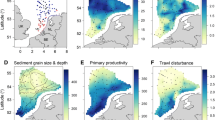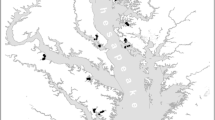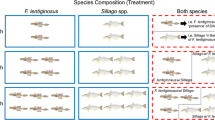Abstract
Bottom trawling is associated with reduced biomass and production in the marine benthic community. Abundance of hard-bodied organisms such as bivalves, crustaceans and echinoderms typically declines in favour of soft-bodied opportunists such as polychaetes. Trawling effects vary with habitat; impact and recovery time are typically greater for more complex substrates/communities and those with lower rates of natural disturbance. Benthic organisms represent the prey base of a large component of the demersal fish assemblage. Hence, trawling-induced change in benthic community structure and function may exert an indirect effect on feeding success and growth of important commercially exploited fishes such as plaice Pleuronectes platessa. We present habitat-specific mixed effects models of plaice length as a function of age, bottom-trawling effort, population density and near-bottom temperature, with sampling year and area, and fish sex incorporated as random effects. Across an observed gradient of trawling effort in the Celtic Sea, plaice on gravel habitat showed significant declines in length at age while plaice on sand habitat showed significant increases in length at age. Contrasting trawling effects likely reflect dietary differences between habitats. Plaice on sand substrates are known to consume predominately polychaetes, which may proliferate at moderate trawling intensity in this habitat. Conversely, plaice on gravel substrates are reported to consume more of the fragile organisms such as echinoderms and bivalves that show marked declines with bottom trawling. An indirect effect of trawling on prey availability and growth of demersal fish has substantial implications for fisheries sustainability via reduced ecosystem carrying capacity and production of commercial fish.


Similar content being viewed by others

References
Amezcua F, Nash RDM, Veale L (2003) Feeding habits of the order Pleuronectiformes and its relation to the sediment type in the North Irish Sea. J Mar Biol Assoc UK 83:593–601
Callaway R, Engelhard GH, Dann J, Cotter J, Rumohr H (2007) A century of North Sea epibenthos and trawling: comparison between 1902–1912, 1982–1985 and 2000. Mar Ecol Prog Ser 346:27–43
Choi JS, Frank KT, Leggett WC, Drinkwater K (2004) Transition to an alternate state in a continental shelf ecosystem. Can J Fish Aquat Sci 61:505–510
Clarke A, Johnston NM (1999) Scaling of metabolic rate with body mass and temperature in teleost fish. J Anim Ecol 68:893–905
Collie JS, Hall SJ, Kaiser MJ, Poiner IR (2000) A quantitative analysis of fishing impacts on shelf-sea benthos. J Appl Ecol 69:785–798
Emmerson MC, Raffaelli D (2004) Predator–prey body size, interaction strength and the stability of a real food web. J Anim Ecol 73:399–409
Hiddink JG, Hutton T, Jennings S, Kaiser MJ (2006) Predicting the effect of area closures and fishing effort restrictions on the production, biomass, and species richness of benthic invertebrate communities. ICES J Mar Sci 63:822–830
Hiddink JG, Rijnsdorp AD, Piet G (2008) Can bottom trawling disturbance increase food production for a commercial fish species? Can J Fish Aquat Sci 65:1393–1401
Hinz H, Bergmann M, Shucksmith R, Kaiser MJ, Rogers SI (2006) Habitat association of plaice, sole and lemon sole in the English Channel. ICES J Mar Sci 63:912–927
Hinz H, Prieto V, Kaiser MJ (2009) Trawl disturbance on benthic communities: chronic effects and experimental predictions. Ecol Appl 19:761–773
Hughes NF, Grand TC (2000) Physiological ecology meets the ideal free distribution: predicting the distribution of size-structured fish populations across temperature gradients. Environ Biol Fish 59:285–298
Hunter E, Metcalfe JD, Reynolds JD (2003) Migration route and spawning area fidelity by North Sea plaice. P Roy Soc B Biol Sci 270:2097–2103
ICES (2009) Report of the international bottom trawl survey working group (IBTSWG), 30 March–3 April 2009, Bergen, Norway. ICES CM 2009/RMC:04. 241 pp
Jennings S, Pinnegar JK, Polunin NVC, Warr KJ (2001) Impacts of trawling disturbance on the trophic structure of benthic invertebrate communities. Mar Ecol Prog Ser 213:127–142
Jennings S, Nicholson MD, Dinmore T, Lancaster JE (2002) Effects of chronic trawling disturbance on the production of infaunal communities. Mar Ecol Prog Ser 243:251–260
Kaiser MJ, Ramsay K, Richardson CA, Spencer FE, Brand AR (2000) Chronic fishing disturbance has changed shelf sea benthic community structure. J Appl Ecol 69:494–503
Kaiser MJ, Clarke KR, Hinz H, Austen MCV, Somerfield PJ, Karakassis I (2006) Global analysis of response and recovery of benthic biota to fishing. Mar Ecol Prog Ser 311:1–11
Kenchington ELR, Gilkinson KD, MacIsaac KG, Bourbonnais-Boyce C, Kenchington TJ, Smith SJ, Gordon DC Jr (2006) Effects of experimental otter trawling on benthic assemblages on Western Bank, Northwest Atlantic Ocean. J Sea Res 56:249–270
Lloret J, Planes S (2003) Condition, feeding and reproductive potential of white seabream Diplodus sargus as indicators of habitat quality and the effect of reserve protection in the Northwestern Mediterranean. Mar Ecol Prog Ser 248:197–208
Lloret J, Demestre M, Sanchez-Pardo J (2007) Lipid reserves of red mullet (Mullus barbatus) during pre-spawning in the Northwestern Mediterranean. Sci Mar 71:269–277
Lorenzen K, Enberg K (2002) Density-dependent growth as a key mechanism in the regulation of fish populations: evidence from among-population comparisons. P Roy Soc B Biol Sci 269:49–54
McConnaughey RA, Smith KR (2000) Associations between flatfish abundance and surficial sediments in the eastern Bering Sea. Can J Fish Aquat Sci 57:2410–2419
Piet GJ, Pfisterer AB, Rijnsdorp AD (1998) On factors structuring the flatfish assemblage in the southern North Sea. J Sea Res 40:143–152
Rijnsdorp AD, van Leeuwen PI (1996) Changes in growth of North Sea plaice since 1950 in relation to density, eutrophication, beam-trawl effort, and temperature. ICES J Mar Sci 53:1199–1213
Rijnsdorp AD, Vingerhoed B (2001) Feeding of plaice Pleuronectes platessa L. and sole Solea solea (L.) in relation to the effects of bottom trawling. J Sea Res 45:219–229
Tillin HM, Hiddink JG, Jennings S, Kaiser MJ (2006) Chronic bottom trawling alters the functional composition of benthic invertebrate communities on a sea-basin scale. Mar Ecol Prog Ser 318:31–45
Venables WN, Ripley BD (2002) Modern applied statistics with S, 4th edn. Springer, New York
Wimpenny RS (1953) The Plaice (being the Buckland Lectures for 1949). Edward Arnold & Co., London
Zuur AF, Ieno EN, Walker NJ, Saveliev AA, Smith GM (2009) Mixed effects models and extensions in ecology with R. Statistics for biology and health. Springer Science and Business Media. 573 pp
Acknowledgments
This study relied on data from the Irish Groundfish Survey, being supplied by the Irish Marine Institute. S. Shephard was funded through a grant to D. Brophy from the Department of Education Ireland, Technological Sector Research: Strand III Core Research Strengths Enhancement Programme. Two anonymous reviewers and the associate editor Fabio Bulleri made insightful and useful comments that improved the final manuscript.
Author information
Authors and Affiliations
Corresponding author
Additional information
Communicated by F. Bulleri.
Rights and permissions
About this article
Cite this article
Shephard, S., Brophy, D. & Reid, D.G. Can bottom trawling indirectly diminish carrying capacity in a marine ecosystem?. Mar Biol 157, 2375–2381 (2010). https://doi.org/10.1007/s00227-010-1502-9
Received:
Accepted:
Published:
Issue Date:
DOI: https://doi.org/10.1007/s00227-010-1502-9



